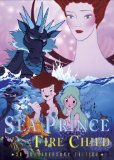| Reviews & Columns |
|
Reviews DVD TV on DVD Blu-ray 4K UHD International DVDs In Theaters Reviews by Studio Video Games Features Collector Series DVDs Easter Egg Database Interviews DVD Talk Radio Feature Articles Columns Anime Talk DVD Savant Horror DVDs The M.O.D. Squad Art House HD Talk Silent DVD
|
DVD Talk Forum |
|
|
| Resources |
|
DVD Price Search Customer Service #'s RCE Info Links |
|
Columns
|
|
|
Sea Prince & The Fire Child (aka The Legend of Sirius)
Discotek Media // Unrated // August 31, 2010
List Price: $19.95 [Buy now and save at Amazon]
The Film:
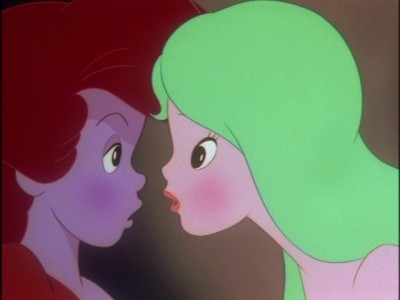 Image William Shakespeare's "Romeo and Juliet", only the Montagues and Capulets are elemental fairies and Verona exists as the expanses of the sea and sky in a majestic world. That's precisely what Masami Hata accomplishes with Sea Prince and the Fire Child, also known as Shiriusu no Densetsu or The Legend of Sirius, a lesser-known piece of Japanese animation from the early '80s spawned from Hello Kitty and Unico creators Sanrio. Don't assume, though, that it's a throwaway children's take on Shakespeare's work, cranked out from the "cute factory" in hopes of selling merchandise; while it does skew towards softer, charming models for its characters in a familiar Disney-like manner, the broad-scaled animation design balances peculiarity with loveliness into a burst of striking, simply-told artistry.
Image William Shakespeare's "Romeo and Juliet", only the Montagues and Capulets are elemental fairies and Verona exists as the expanses of the sea and sky in a majestic world. That's precisely what Masami Hata accomplishes with Sea Prince and the Fire Child, also known as Shiriusu no Densetsu or The Legend of Sirius, a lesser-known piece of Japanese animation from the early '80s spawned from Hello Kitty and Unico creators Sanrio. Don't assume, though, that it's a throwaway children's take on Shakespeare's work, cranked out from the "cute factory" in hopes of selling merchandise; while it does skew towards softer, charming models for its characters in a familiar Disney-like manner, the broad-scaled animation design balances peculiarity with loveliness into a burst of striking, simply-told artistry.
The story, just like Shakespeare's play, roots in a conflict between two factions -- children of water, led by Oceanus, and children of fire, led by Hyperia -- and a love that sparks underneath their bickering. At one point, the two elemental gods got along wonderfully, combining into a harmonious fog to relish in their connection. Now, however, they're pried apart into an endless, battle-free quarrel where each side forbids association with the other, demonizing one another as "barbaric" and "evil". To keep the balance, guardians from each group oversee the relics of a war that waged between the two groups, with Prince Sirius overseeing a mystical eye and Princess Malta protecting the "Holy Flame" that's never to be extinguished. It all operates like clockwork, until the two youngsters meet in the Forbidden Zone.
Sea Prince and the Fire Child has a distinct Greco-Roman air about its tale of warring gods and magical items that maintain worldly balance, which crafts a expansive mythos behind this clear-cut, sleek take on "Romeo and Juliet". In the beginning, Masami Hata's vibrant depictions of both worlds create a lively atmosphere, admiringly duplicating Disney's signature, whimsical outlook on fantasy. Idiosyncratic characters liven up the manner even more, such as a dopily fiendish sea lizard that wants Sirius' crown and a zippy Tinkerbell-like sprite riding Malta's backside about protecting the flame, all who seamlessly fit against the backdrop of the picture's storytelling. As boisterous slapstick and situational humor inks into the film, the tone clearly gravitates towards holding younger attention spans -- yet still controlling itself enough to not off-put older minds.
But as Malta and Sirius' romance blossoms, the conflict erupts again between the two elemental factions, and death creeps into the picture, Sea Prince and the Fire Child ventures into mature grounds. Yet, cleverly, it still maintains that same youth-centered poise it generates at the beginning, showing a level of sophistication and thematic initiative -- some anti-war bits, others about family conflict resolution -- that stretches beyond the picture's earlier aims and slips into the dreary aspects of the story with a perceptive level of abandon. Masami Hata and screenwriter Chiho Katsura, who oddly also penned the script for Nobuhiko Obayashi's insane fantasy-horror hybrid Hausu (House), exercise control over these mixed light and dark tones that other family-friendly fantasies can't juggle, like the compelling but tonally off-kilter The Black Cauldron.
Masami Hata's animation style for Sea Prince and the Fire Child, however, becomes the film's unquestionable draw, which infuses sensible, lively character models and intricate backdrops into a surprisingly elegant piece of '80s-era anime. Sanrio's crew gathers clear influence from Disney's Pinocchio, Sleeping Beauty, and Fantasia in its exotic construction -- especially in combination with the riffs on classical pieces in Koichi Sugiyama's scoring -- and blends it with a judicious use of psychedelic artistry to give it unique slant, all while never stepping on the storytelling's toes in its lavishness. Intricate columns, lush oceanic vegetation, earthy underground silt, and heavenly cloud-covered staircases all populate its design, showcasing designs reminiscent of Miyazaki's Nausicaa of the Valley of the Wind and Disney's own The Little Mermaid, both from later in the '80s. It wouldn't surprise me to learn that Masami Hata's construction had a hand in influencing them.
The end result is dazzling, a sweeping stream of imagery that tells its clear-cut tale with a level of poetic, fanciful wonder that'll be particularly enjoyable for those who savor abstract takes on William Shakespeare's work. Personally, I take a lot of delight in placing these out-of-the-box takes on the bard's plays in context of the original works, from the likes of Kurosawa's Throne of Blood as an adaptation of Macbeth to the Hong Kong martial arts picture The Banquet as a take on Hamlet, so seeing Masami Hata get his hands dirty with a capricious variant on "Romeo and Juliet" became a delightful experience. Even taking that element out of the equation, the experience in simply watching the animation tell a splendid and easy-going -- not to mention quite affective -- little fantasy tale in this manner becomes a joy on its own.
Since words can only go so far in describing the artistry behind Sea Prince and the Fire Child, let's allow for some still shots from this rare little film to speak for themselves:
The DVD:
Only previously available by way of a VHS tape from '91 in North America, Sea Prince and the Fire Child arrives from Discotek's Eastern Star branch in a 30th Anniversary Special Edition DVD. The menus appear to have been designed for a full-frame aspect ratio, but it's actually stretched out to 16x9 to fill flat-panel televisions.
Video and Audio:
Chuck out your VHS tapes, boys and girls. Presented in its original aspect ratio of 1.33:1, as indicated by the back of Eastern Star's packaging, it's hard to imagine Sea Prince and the Fire Child looking much better than this. Blasts of robust shades from nearly every point in the color gradient pour through, while the details of the actual animation are preserved with impressive detail rendering -- clean, sharp lines around the characters without unsightly edge halos (with the exception of one or two instances that may be inherent with the print), solid blocks of bold color, rich contrast presentation, and the intricacy of brush strokes in the backdrops. Though beautiful and far better than what'd be expected for this lost gem, the transfer isn't perfect; it suffers from a healthy amount of dust/speckle damage through a vast majority of the film, while also exhibiting some combing, sporadic ghosting issues, and a handful of scenes with bleeding edges along the contours of the animation. That, however, shouldn't deter one from experiencing the beauty of this film, which looks exquisite in this standard-definition image. To say the least, Sea Prince and the Fire Child doesn't look its age.
Note: Click each of the two images below for a full-sized still shot from the DVD.
Eastern Star have also done an admirable thing with the audio for Sea Prince and the Fire Child, offering both the original Japanese language track and the English dub -- both of which are 2-channel tracks. And they're rather good when looked at for their technical quality, exhibiting clear dialogue, punchy '80s-era sound effects, and a decently-balanced carriage with the film's scoring. But, without question, Masami Hata's film should be watched with the original Japanese language track, as the English dub really isn't very good from either a vocal or translation standpoint. The Japanese subtitles, with aren't at all taken from the English language track, showcase a rich language and grammatical correctness that add volumes to the experience in watching the film. Nostalgia (or personal option) might draw some viewers to the English language track, but I heartily recommend the finely-handled original Japanese language option.
Special Features:
The only real negative to this 30th Anniversary disc comes in the supplements -- well, lack thereof, as all that's available for Sea Prince and the Fire Child is a Trailer (4:25, 4x3). It does, however, offer an interesting opportunity to show the difference between the way the film could've looked had it been sloppily slapped onto a disc (washed out, blurry, and somewhat lifeless), and how it appears on this anniversary DVD. Here's an example:
Note: Click each of the two images below for a full-sized still shot from the DVD.
Jut chalk up the opportunity to own the film on DVD -- with the original Japanese language track AND Japanese subtitles -- as enough of a bonus, though it obviously would've been great to see concept art or hear a commentary about its conception.
Final Thoughts:
There's the very good chance you've never heard of Sea Prince and the Fire Child, or for that matter The Legend of Sirius, and that's something you should change. It's a sublime piece of accessible fantasy anime from Masami Hata that tells a streamlined, whimsical rendition of William Shakespeare's "Romeo and Juliet", one that's handled in a gorgeously peculiar fashion that's able to be absorbed and relished by both children and discerning adults. Eastern Star makes it a whole heck of a lot easier to watch the film, presented in a beautiful -- though flawed -- visual transfer and both Japanese and English language options. Even though there's next to nothing available for extras, the availability to actually see this rare film with supremely satisfying audiovisual merits at an affordable price ($20 list) makes it a Highly Recommended disc. What a wonderful surprise.
Thomas Spurlin, Staff Reviewer -- DVDTalk Reviews | Personal Blog/Site
 Image William Shakespeare's "Romeo and Juliet", only the Montagues and Capulets are elemental fairies and Verona exists as the expanses of the sea and sky in a majestic world. That's precisely what Masami Hata accomplishes with Sea Prince and the Fire Child, also known as Shiriusu no Densetsu or The Legend of Sirius, a lesser-known piece of Japanese animation from the early '80s spawned from Hello Kitty and Unico creators Sanrio. Don't assume, though, that it's a throwaway children's take on Shakespeare's work, cranked out from the "cute factory" in hopes of selling merchandise; while it does skew towards softer, charming models for its characters in a familiar Disney-like manner, the broad-scaled animation design balances peculiarity with loveliness into a burst of striking, simply-told artistry.
Image William Shakespeare's "Romeo and Juliet", only the Montagues and Capulets are elemental fairies and Verona exists as the expanses of the sea and sky in a majestic world. That's precisely what Masami Hata accomplishes with Sea Prince and the Fire Child, also known as Shiriusu no Densetsu or The Legend of Sirius, a lesser-known piece of Japanese animation from the early '80s spawned from Hello Kitty and Unico creators Sanrio. Don't assume, though, that it's a throwaway children's take on Shakespeare's work, cranked out from the "cute factory" in hopes of selling merchandise; while it does skew towards softer, charming models for its characters in a familiar Disney-like manner, the broad-scaled animation design balances peculiarity with loveliness into a burst of striking, simply-told artistry. The story, just like Shakespeare's play, roots in a conflict between two factions -- children of water, led by Oceanus, and children of fire, led by Hyperia -- and a love that sparks underneath their bickering. At one point, the two elemental gods got along wonderfully, combining into a harmonious fog to relish in their connection. Now, however, they're pried apart into an endless, battle-free quarrel where each side forbids association with the other, demonizing one another as "barbaric" and "evil". To keep the balance, guardians from each group oversee the relics of a war that waged between the two groups, with Prince Sirius overseeing a mystical eye and Princess Malta protecting the "Holy Flame" that's never to be extinguished. It all operates like clockwork, until the two youngsters meet in the Forbidden Zone.
Sea Prince and the Fire Child has a distinct Greco-Roman air about its tale of warring gods and magical items that maintain worldly balance, which crafts a expansive mythos behind this clear-cut, sleek take on "Romeo and Juliet". In the beginning, Masami Hata's vibrant depictions of both worlds create a lively atmosphere, admiringly duplicating Disney's signature, whimsical outlook on fantasy. Idiosyncratic characters liven up the manner even more, such as a dopily fiendish sea lizard that wants Sirius' crown and a zippy Tinkerbell-like sprite riding Malta's backside about protecting the flame, all who seamlessly fit against the backdrop of the picture's storytelling. As boisterous slapstick and situational humor inks into the film, the tone clearly gravitates towards holding younger attention spans -- yet still controlling itself enough to not off-put older minds.
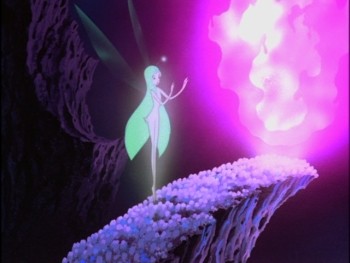 | 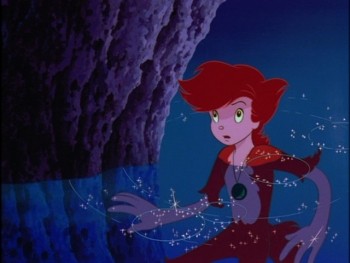 |
But as Malta and Sirius' romance blossoms, the conflict erupts again between the two elemental factions, and death creeps into the picture, Sea Prince and the Fire Child ventures into mature grounds. Yet, cleverly, it still maintains that same youth-centered poise it generates at the beginning, showing a level of sophistication and thematic initiative -- some anti-war bits, others about family conflict resolution -- that stretches beyond the picture's earlier aims and slips into the dreary aspects of the story with a perceptive level of abandon. Masami Hata and screenwriter Chiho Katsura, who oddly also penned the script for Nobuhiko Obayashi's insane fantasy-horror hybrid Hausu (House), exercise control over these mixed light and dark tones that other family-friendly fantasies can't juggle, like the compelling but tonally off-kilter The Black Cauldron.
Masami Hata's animation style for Sea Prince and the Fire Child, however, becomes the film's unquestionable draw, which infuses sensible, lively character models and intricate backdrops into a surprisingly elegant piece of '80s-era anime. Sanrio's crew gathers clear influence from Disney's Pinocchio, Sleeping Beauty, and Fantasia in its exotic construction -- especially in combination with the riffs on classical pieces in Koichi Sugiyama's scoring -- and blends it with a judicious use of psychedelic artistry to give it unique slant, all while never stepping on the storytelling's toes in its lavishness. Intricate columns, lush oceanic vegetation, earthy underground silt, and heavenly cloud-covered staircases all populate its design, showcasing designs reminiscent of Miyazaki's Nausicaa of the Valley of the Wind and Disney's own The Little Mermaid, both from later in the '80s. It wouldn't surprise me to learn that Masami Hata's construction had a hand in influencing them.
The end result is dazzling, a sweeping stream of imagery that tells its clear-cut tale with a level of poetic, fanciful wonder that'll be particularly enjoyable for those who savor abstract takes on William Shakespeare's work. Personally, I take a lot of delight in placing these out-of-the-box takes on the bard's plays in context of the original works, from the likes of Kurosawa's Throne of Blood as an adaptation of Macbeth to the Hong Kong martial arts picture The Banquet as a take on Hamlet, so seeing Masami Hata get his hands dirty with a capricious variant on "Romeo and Juliet" became a delightful experience. Even taking that element out of the equation, the experience in simply watching the animation tell a splendid and easy-going -- not to mention quite affective -- little fantasy tale in this manner becomes a joy on its own.
Since words can only go so far in describing the artistry behind Sea Prince and the Fire Child, let's allow for some still shots from this rare little film to speak for themselves:
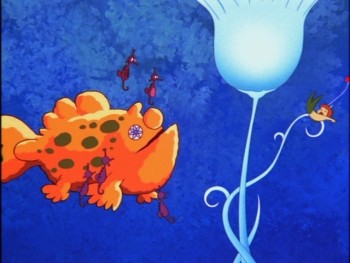 | 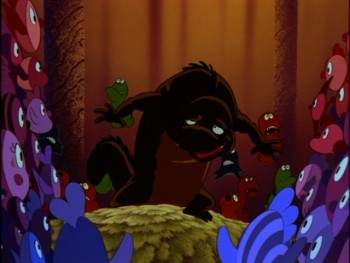 |
 | 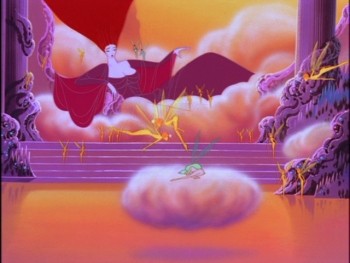 |
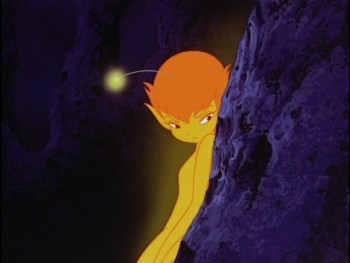 | 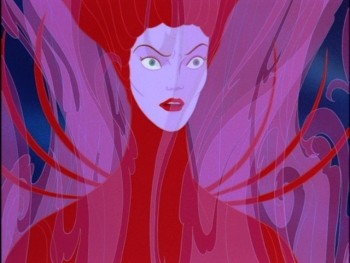 |
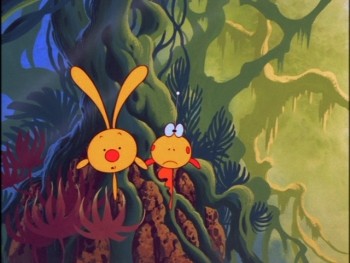 | 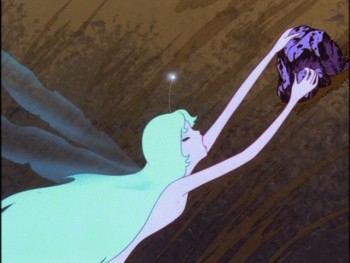 |
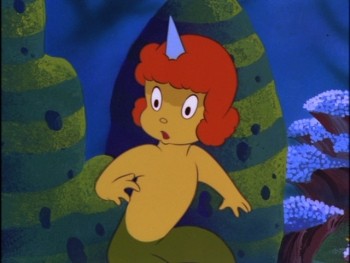 | 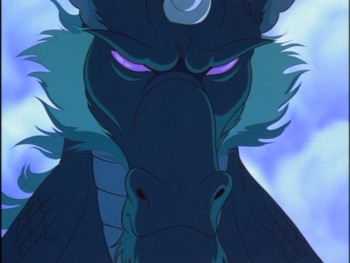 |
The DVD:
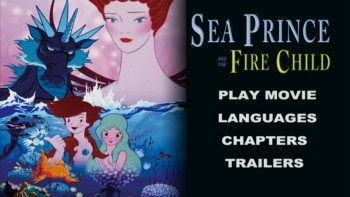 | 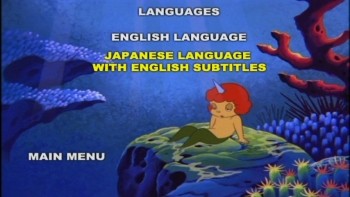 |
Only previously available by way of a VHS tape from '91 in North America, Sea Prince and the Fire Child arrives from Discotek's Eastern Star branch in a 30th Anniversary Special Edition DVD. The menus appear to have been designed for a full-frame aspect ratio, but it's actually stretched out to 16x9 to fill flat-panel televisions.
Video and Audio:
Chuck out your VHS tapes, boys and girls. Presented in its original aspect ratio of 1.33:1, as indicated by the back of Eastern Star's packaging, it's hard to imagine Sea Prince and the Fire Child looking much better than this. Blasts of robust shades from nearly every point in the color gradient pour through, while the details of the actual animation are preserved with impressive detail rendering -- clean, sharp lines around the characters without unsightly edge halos (with the exception of one or two instances that may be inherent with the print), solid blocks of bold color, rich contrast presentation, and the intricacy of brush strokes in the backdrops. Though beautiful and far better than what'd be expected for this lost gem, the transfer isn't perfect; it suffers from a healthy amount of dust/speckle damage through a vast majority of the film, while also exhibiting some combing, sporadic ghosting issues, and a handful of scenes with bleeding edges along the contours of the animation. That, however, shouldn't deter one from experiencing the beauty of this film, which looks exquisite in this standard-definition image. To say the least, Sea Prince and the Fire Child doesn't look its age.
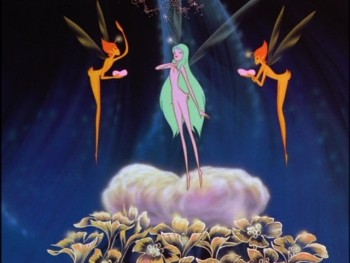 | 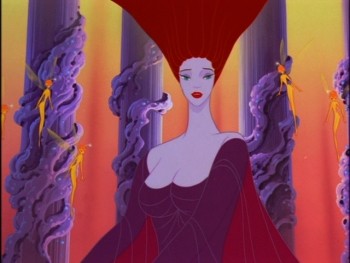 |
Eastern Star have also done an admirable thing with the audio for Sea Prince and the Fire Child, offering both the original Japanese language track and the English dub -- both of which are 2-channel tracks. And they're rather good when looked at for their technical quality, exhibiting clear dialogue, punchy '80s-era sound effects, and a decently-balanced carriage with the film's scoring. But, without question, Masami Hata's film should be watched with the original Japanese language track, as the English dub really isn't very good from either a vocal or translation standpoint. The Japanese subtitles, with aren't at all taken from the English language track, showcase a rich language and grammatical correctness that add volumes to the experience in watching the film. Nostalgia (or personal option) might draw some viewers to the English language track, but I heartily recommend the finely-handled original Japanese language option.
Special Features:
The only real negative to this 30th Anniversary disc comes in the supplements -- well, lack thereof, as all that's available for Sea Prince and the Fire Child is a Trailer (4:25, 4x3). It does, however, offer an interesting opportunity to show the difference between the way the film could've looked had it been sloppily slapped onto a disc (washed out, blurry, and somewhat lifeless), and how it appears on this anniversary DVD. Here's an example:
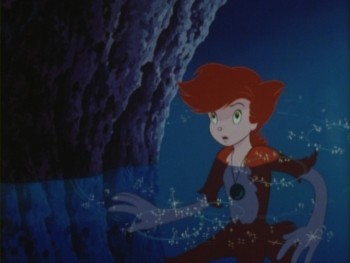 |  |
| | |
Jut chalk up the opportunity to own the film on DVD -- with the original Japanese language track AND Japanese subtitles -- as enough of a bonus, though it obviously would've been great to see concept art or hear a commentary about its conception.
Final Thoughts:
There's the very good chance you've never heard of Sea Prince and the Fire Child, or for that matter The Legend of Sirius, and that's something you should change. It's a sublime piece of accessible fantasy anime from Masami Hata that tells a streamlined, whimsical rendition of William Shakespeare's "Romeo and Juliet", one that's handled in a gorgeously peculiar fashion that's able to be absorbed and relished by both children and discerning adults. Eastern Star makes it a whole heck of a lot easier to watch the film, presented in a beautiful -- though flawed -- visual transfer and both Japanese and English language options. Even though there's next to nothing available for extras, the availability to actually see this rare film with supremely satisfying audiovisual merits at an affordable price ($20 list) makes it a Highly Recommended disc. What a wonderful surprise.
|
| Popular Reviews |
| Sponsored Links |
|
|
| Sponsored Links |
|
|
| Release List | Reviews | Shop | Newsletter | Forum | DVD Giveaways | Blu-Ray | Advertise |
|
Copyright 2024 DVDTalk.com All Rights Reserved. Legal Info, Privacy Policy, Terms of Use,
Manage Preferences,
Your Privacy Choices | |||||||









